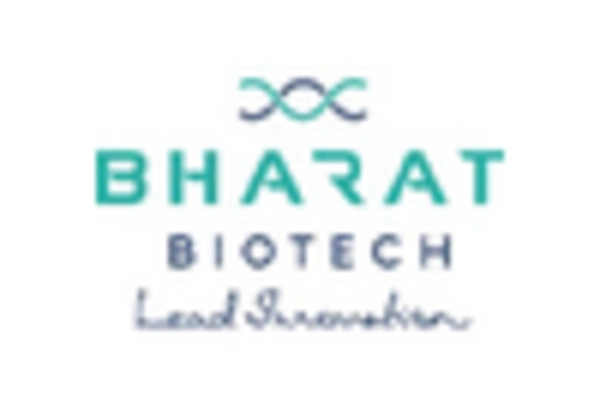The Rotavirus Prophylaxis Market is characterized by a dynamic competitive landscape, driven by increasing awareness of rotavirus infections and the critical need for effective vaccination strategies. Key players such as Merck & Co. (US), GlaxoSmithKline (GB), and Takeda Pharmaceutical Company (JP) are at the forefront, each adopting distinct strategies to enhance their market presence. Merck & Co. (US) focuses on innovation, particularly in developing next-generation vaccines, while GlaxoSmithKline (GB) emphasizes strategic partnerships to expand its distribution networks. Takeda Pharmaceutical Company (JP) is actively pursuing regional expansion, particularly in emerging markets, which appears to be a significant growth driver in the current landscape. Collectively, these strategies contribute to a competitive environment that is increasingly characterized by collaboration and innovation.
In terms of business tactics, companies are localizing manufacturing to reduce costs and enhance supply chain efficiency. This approach is particularly relevant in the context of the Rotavirus Prophylaxis Market, which is moderately fragmented, with several players vying for market share. The collective influence of these key players shapes a competitive structure that encourages both innovation and strategic partnerships, as companies seek to leverage each other's strengths to enhance their offerings.
In August 2025, Merck & Co. (US) announced a collaboration with a leading biotechnology firm to develop a novel rotavirus vaccine aimed at improving efficacy and reducing side effects. This strategic move is likely to bolster Merck's position in the market, as it aligns with the growing demand for safer and more effective vaccination options. The partnership not only enhances Merck's research capabilities but also positions it to respond more effectively to emerging health challenges.
In September 2025, GlaxoSmithKline (GB) launched a new initiative aimed at increasing vaccine accessibility in low-income regions. This initiative, which includes partnerships with local health organizations, underscores GlaxoSmithKline's commitment to global health equity. By focusing on accessibility, the company not only enhances its corporate social responsibility profile but also expands its market reach, potentially leading to increased sales in underserved areas.
In July 2025, Takeda Pharmaceutical Company (JP) expanded its manufacturing capabilities in Southeast Asia, a strategic decision aimed at meeting the rising demand for rotavirus vaccines in the region. This expansion is indicative of Takeda's proactive approach to market dynamics, as it seeks to capitalize on the growing need for vaccines in emerging markets. By enhancing its production capacity, Takeda is well-positioned to respond to fluctuations in demand and strengthen its competitive edge.
As of October 2025, the Rotavirus Prophylaxis Market is witnessing trends that emphasize digitalization, sustainability, and the integration of artificial intelligence in vaccine development and distribution. Strategic alliances are increasingly shaping the competitive landscape, as companies recognize the value of collaboration in addressing complex health challenges. Looking ahead, competitive differentiation is likely to evolve, with a shift from price-based competition to a focus on innovation, technological advancements, and supply chain reliability. This transition suggests that companies that prioritize these areas will be better positioned to thrive in an increasingly competitive market.

















Leave a Comment